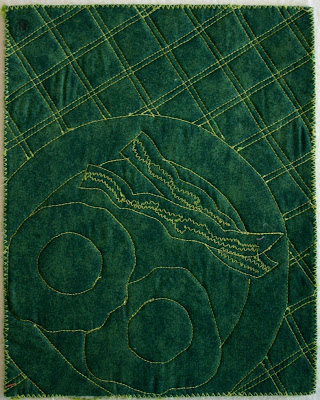Quilts # 31 – 32 - 33
These were fun to make little quilts!
 |
| Monochromatic - Complimentary - Analogous |
Challenge – I wanted to make 3 quilt pages using the same simple design in in three different colour schemes, changing up some of the embellishments and stitching and/or quilting for interest.
 |
| Monochromatic Colour Scheme |
Quilt # 31
Bacon and Eggs 1 - Monochromatic (One hue, including its tints and shades)
Techniques - Using Green
Cut and sprayed the “plate” with 505 Temporary Adhesive, used a small zigzag stitch over a straight stitch around the edge.
Embroidered a machine design to decorate the plate. Folded “bacon” fabric back and forth and zigzagged in to obtain crinkled fried bacon look.
 |
| Monochromatic - back |
Cut “egg whites” and burned the edges and stitched just inside the burned area with invisible thread. Bright green egg yolks completed the top.
Quilting – Invisible thread outlined the plate and food, stitched a line about an inch inside the edge of the plate for dimension.
Quilted background in off centre grid using 2 different greens.
Edges – Couched wool around edge for binding.
Back - “Background” fabric.
Date Made – January 20, 2007
 |
| Complimentary Colour Scheme |
Quilt #32
Bacon and Eggs 2 – Complimentary (any pair of hues which are opposite one another on the colour wheel)
Techniques - Using Orange and Blue
Edge of “plate” was left raw edged and stitched with a straight stitch and a decorative design was added.
The bacon was made as in #1.
Used orange tulle for the “fried edges and overlayed organza over the egg white printed fabric.
The blue egg yolk were zigzagged in place.
 |
| Complimentary- back |
Quilting – Outline quilted the design and stitched on both sides of embroidered decorative plate design. The background was quilted with a curvy stitch from my machine, all quilting done with invisible thread.
Edges – Zigzagged edges with a peach thread.
Back - “Egg white” fabric.
Date Made – January 27, 2007
 |
| Analogous Colour Scheme |
Quilt #33
Bacon and Eggs 3 - Analogous
(Hues that are adjacent or next to each
other on the colour wheel)
Techniques - Using Violet, Purple, Blue, Blue green and Yellow green, varying the values for contrast.
Zigzagged edges of plate and added a stitched decorative stitch.
The “bacon” fabric already had a crinkly look so just zigzagged the edges on it and the egg yolk and egg white using a purple thread. The egg white fabric is a light yellow green hand dyed and the yolk has a blue green checked printed fabric.
 |
| Analogous - back |
Quilting – All the quilting was done using a variegated rayon thread. The design was outline quilted, free motion loopy loops lines on the background, stippling in the centre of the plate and wavy lines on the bacon.
Edges – Finished with a decorative stitch.
Back - “Plate” fabric.
Date Made – February 3, 2007
Conclusions – These were fun to make and choosing fabric following a “plan” eases the process of understanding how colour schemes work.
Maker – Terry Whyte
Have a great day!
Terry


















